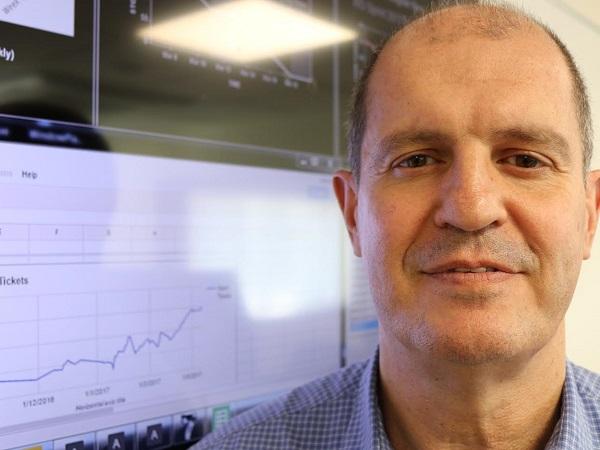
Date: 5 April 2018
“The window industry is very fragmented. We still rely on volume, ‘frames per week’ as a measure of success. What we should be measuring is our ability to not just meet customer need but how effective we are at giving the customer what they want”, says Roberto Canassa, Director of IT, Emplas.
He continues: “We need to understand what the customer values, how we meet and can measure it and the key points which underpin the delivery of our customer promise.
“The connected factory isn’t about machinery or IT systems and software, it’s about what they gives us in understanding and visibility and how we pass on the benefits of that to the customer in better service or lower costs.”
Roberto argues there are three ‘tiers’ to this process. First understand the customer, what they value and your own proposition in relation to it. Two, measure what you deliver against this base line and three, drive operational efficiencies to add value to your customer offer.

“This is why IT and software is so important. We can measure customer experience from the receipt of their very first order, our own performance in manufacture and service right up to the point of delivery”, he says.
Emplas’ has been an early-adopter of technology. It launched its online ordering system and Window Designer in 2003, its Door Designer early in 2016 and U-Design, Ultraframe’s conservatory design software in 2015.
Accessed via the manufacturer’s Online Portal or EVA, the Emplas Virtual Assistant launched in 2014, installers can log-on from any PC, laptop, tablet or mobile phone, to access a secure quoting and order processing system. Orders can be tracked in real time as they progress right up to the point of delivery.
The product of a six-figure spend on cloud technologies and networking infrastructures underpimed by investment on the ground in its now seven-strong IT team, plus three dedicated software programmers, lead management tools, allow Emplas customers to track enquiries and conversions.
Quotation software automatically pulls in relevant data, automatically applying discounts, cutting the time to create a quote to minutes. These are stored ready to order, which can again be triggered automatically. Most importantly, everything is integrated, data is inputted once and once only.
“It’s another example of how fragmented the industry is”, continues Roberto. “The industry in general uses multiple systems to quote, to order, to track data. We have removed the requirement to input data into multiple platforms by integrating them.
“EVA is a ‘middleware’ platform, it pulls in data and information from multiple software platforms, integrates it, scrubs it, makes sense of it and delivers data that our customers can use to inform their business strategies.”
Emplas is applying the same principles to fabrication. It completed a major extension adding around a third again to its manufacturing facility at the end of 2017, the new development housing new lines, loading bays and offices.
This was accompanied by a £1.4m spend on machinery to add a second Schirmer machining and cutting centre, multiple Rotox welders and saws, bringing its weekly capacity up to 2,500 frames on a single shift. All of this, underpinned by a corresponding investment in its IT infrastructure and systems.
“We are in the process of introducing Microsoft BI across the business as part of our IT strategy to increase visibility across the business”, explains Roberto. “It empowers the user to ‘slide and dice’ the data, customizing it to the requirements of the individual user from a single data source.
“We input the data once and we can manipulate and apply filters to support any number of analysies, which gives us full visibility across the business.
“That’s very important in understanding and measuring how we deliver what the customer wants - not just what the customer needs.”
This means that Emplas production schedule is not only managed through a central system but the outputs and data generated as part of the production cycle are also collated, information which it is using to deliver new efficiencies and better customer experience. This includes production modelling to identify challenges ahead of time.
“We manufacture lots of different products, we buy some products in, lead times are different. In recognizing this we can can work out what we need to do and when, ahead of day zero – delivery day so that we guarantee that we deliver on time and in full”, says Roberto.
This process exploits Emplas’ bar code tracking system to identify delivery critical ‘stage gates’ which the product must pass through by a certain time to guarantee that its ready for delivery. If a product misses a gate, it will trigger an alert on the system, flagging potential problems earlier in the production cycle so that log-jams can be identified and corrective action taken before it impacts on the customer.
“It gives us a map. We can see what’s green, what’s red and potential problems and correct them before they actually become problems”, says Roberto.
“We want to be a little like a swan on the surface of the lake. We need to appear majestic, it needs to look effortless, when under the surface, we have a lot of systems in place to make sure that we’re continually operating efficiently to achieve ‘day zero’ and guaranteed delivery.”
Roberto also sees the influence of IT and software growing as the industry moves, forward, highlighting the potential applications of augmented reality in retail. This exploits and superimposes computer generated images on the users ‘real-world’ view.
“From an e-commerce perspective, augmented reality has the potential to have a huge impact on retail, transforming our approach as an industry” Roberto suggests.
“We’re committed to utilizing and levering the potential benefits that edge technologies can deliver for our customers. Augmented reality has a multitude of potential applications.”
 600450
600450























Add new comment